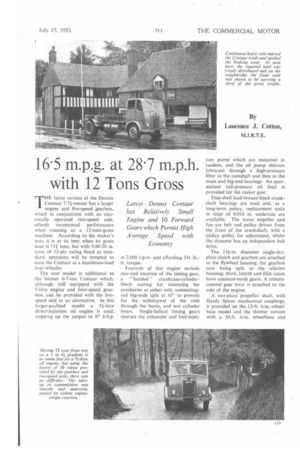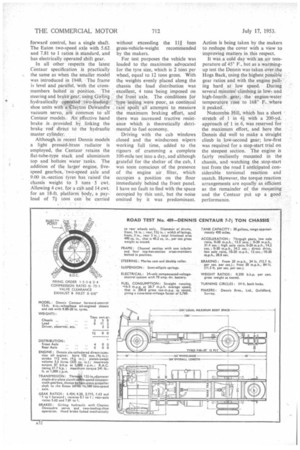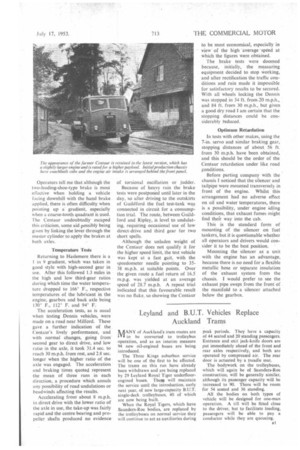16 - 5 m.p.g. at 28 . 7 m.p.h.
Page 33

Page 34

Page 35

If you've noticed an error in this article please click here to report it so we can fix it.
with 12 Tons Gross
HE latest version of the Dennis Centaur 7-71-tonner has a larger engine and five-speed gearbox, which in conjunction with an electrically operated two-speed axle, affords exceptional performance when running as a 12-tons-gross machine. According to the maker's tests it is at its best when its gross load is 111 tons, but with 9.00-20 in. tyres of 12-ply rating fitted as standard, operators will be tempted to treat the Centaur as a maximum-load four-wheeler.
The new model is additional to the former 6-7-ton Centaur which, although still equipped with the 5-litre engine and four-speed gearbox, can be provided with the fivespeed unit as an alternative. In this larger-payload model a 5i-litre direct-injection oil engine is used, stepping up the output to 87 b,h.p. at 2,000 r.p.m. and affording 241 lb.it. torque.
Features of this engine include rear-end location of the timing gear, a " handed " crankcase-cylinderblock casting for mounting the auxiliaries at either side, connectingrod big-ends split at 450 to provide for the withdrawal of the rods through the bores, and wet cylinder liners. Single-helical timing gears operate the exhauster and fuel-injee
lion pump which are mounted in tandem, and the oil pump delivers lubricant through a high-pressure filter to the camshaft and then to the main and big-end bearings. An intermittent full-pressure oil feed is provided for the rocker gear.
Thin-shell lead-bronze-lined crankshaft bearings are used and, as a long-term policy, replacement units in steps of 0.010 in. undersize are available. The water impeller and fan are belt and pulley driven from the front of the crankshaft, with a jockey pulley for adjustment, whilst the dynamo has an independent belt drive.
The 131-in. diameter single-dryplate clutch and gearbox are attached to the flywheel housing, the gearbox case being split at the selector housing; third, fourth and fifth ratios have constant-mesh gears. A remotecontrol gear lever is attached to the side of the engine.
A two-piece propeller shaft, with Hardy Spicer mechanical couplings, is provided on the 13-ft. 6-in.-wheelbase model and the shorter version with a 10-ft. 6-in, wheelbase and forward control, has a single shaft. The Eaton two-speed axle with 5.62 and 7.81 to 1 ratios is standard, and has electrically operated shift gear.
In all other respects the latest Centaur specification. is practically the same as when the smaller model was introduced in 1948. The frame is level and parallel, with the crossmembers bolted in position. The steering and brake gear, using Girling hydraulically operttted two-ieadingshoe units with etlayton Dewandre vacuum servo, are common to all Centaur models.An effective hand brake is -provided by linking the brake rod direct to the hydraulic master cylinder.
Although in recent Dennis models a light pressed-brass radiator is employed, the Centaur retains the Bat-tube-type stack and aluminium top and bottdm water tanks. The addition of the larger engine, fivespeed gearbox, two-speed axle and 9.00 in.-section. tyres has raised the chassis weight to 3 tons 5 cwt. Allowing 4 cwt. for a cab and 14.ewt, for an 18-ft. platform body, a payload of 7i tons can be carried
without exceeding the 11i tons gross-vehicle-weight recommended by the makers.
For test purposes the vehicle was loaded to the maximum advocated for the tyre size, which is 2 tons per wheel, equal to 12 tons gross. With the weights evenly placed along the chassis the load distribution was excellent, 4 tons being imposed on the front axle. The conditions for type testing were poor, as continual rain spoilt all attempts to measure the maximum braking effort, and there was increased tractive resistance which is theoretically detrimental to fuel economy.
Driving with the cab windows closed and the windscreen wipers working full time, added to the rigours of cramming a complete 100-mile test into a day, and although grateful for the shelter of the cab, I was soon conscious of the presence of the engine air filter, which occupies a position on the floor immediately behind the front panel. I have no fault to find with the space occupied by this unit, but the noise emitted by it was predominant. Action is being taken by the makers to reshape the cover with a view to improving matters in this respect.
It was a cold day with an air temperature of 45° F., but as a warmingup test the Dennis was taken overthe Hogs Back, using the highest possible gear ratios and with the engine pulling hard at low speed. During several minutes' climbing in lowand high-fourth gear, the engine-water temperature rose to 168° F. where it peaked.
Nutcombe Hill, which has a short stretch of 1 in 4i with a 200-yd. approach of 1 in 6, was reserved for the maximum effort, and here the Dennis did well to make a straight climb in low-second gear; low-first was required for a stop-start trial on the steepest section. The engine is fairly resiliently mounted in the chassis, and watching the stop-start test from the road I anticipated considerable torsional reaction and snatch. However, the torque reaction arrangements are equally as efficient as the remainder of the mounting and the Centaur put up a good performance.
Operators tell me that although the two-leading-shoe-type brake is most effective when holding a vehicle facing downhill with the hand brake applied, there is often difficulty_ when pointing up a gradient, especially when a coarse-tooth quadrant is used. The Centaur undoubtedly escaped this criticism, some aid possibly being given by linking the lever through the master cylinder to apply the brakes at both axles.
Temperature Tests Returning to Haslemere there is a 1 in 9 gradient, which was taken in good style with high-second gear in use. After this followed 1.3 miles in the high and low third-gear ratios during which time the water temperature dropped to 166° F., respective temperatures of the lubricant in the engine, gearbox and back axle being 130° F., 112° F. and 94° F.
The acceleration tests, as is usual when testing Dennis vehicles, were made on a road near Milford. These gave a further indication of the Centaur's lively performance, and with normal changes, going from second gear to direct drive, and low ratio in the axle, it took 31.4 sec. to reach 30 m.p.h. from rest, and 2.8 sec. longer when the higher ratio of the axle was engaged. The acceleration and braking times quoted represent the mean of three runs in each direction, a procedure which annuls any possibility of road undulations or headwinds affecting the results.
Accelerating from about 8 m.p.h. in direct drive with the lower ratio of the axle in use, the take-up was fairly rapid and the centre bearing and propeller shafts produced no evidence of torsional oscillation or judder.
Because of heavy rain the brake tests were postponed until later in the day, so after driving to the outskirts of Guildford the fuel test-tank was connected in circuit for a consumption trial. The route, between Guildford and Ripley, is level to undulating, requiring occasional use of low direct-drive and third gear for two short spells.
Although the unladen weight of the Centaur does not qualify it for the higher speed limit, the test vehicle was kept at a fast gait, with the speedometer needle pointing to 3538 m.p.h. at suitable points. Over the given route a fuel return of 16.5 m.p.g. was yielded at an average speed of 28.7 m.p.h. A repeat trial indicated that this favourable result was no fluke, so showing the Centaur to be most economical, especially in view of the high -average speed at which the figures were obtained.
The brake tests were doomed because, initially, the measuring equipment decided to stop working, and after rectification the traffic conditions and rain made it impossible for satisfactory results to be secured. With all wheels locking the Dennis was stopped in 34 ft. from .20 m.p.h., and 84 ft. from 30 m.p.h., but given a good dry road I am certain that the stopping distances could be considerably reduced.
Optimum Retardation In tests with other makes, using the 7-in. servo and similar braking gear, stopping distances of about. 56 ft. from 30 m.p.h. have been obtained, and this should be the order of the Centaur retardation under like road conditions.
Before parting company with the chassis I noticed that the silencer and tailpipe were mounted transversely in front of the engine. Whilst this arrangement had no adverse effect on oil and water temperatures, there is a possibility, under engine idling conditions, that exhaust fumes might find their way into the cab.
This is the standard form of mounting of the silencer on fuel tankers, but it is questionable whether all operators and drivers would consider it to be the best position.
Mounting the silencer as a unit with the engine has an advantage, because there is no need for a flexible metallic hose or separate insulation of the exhaust system from the chassis. I would prefer to see the exhaust pipe swept from the front of the manifold to a silencer attached below the gearbox.




















































































